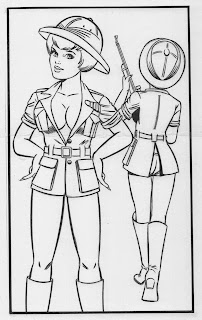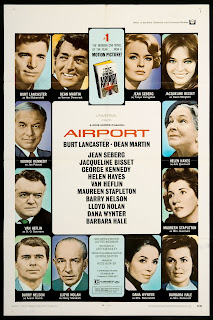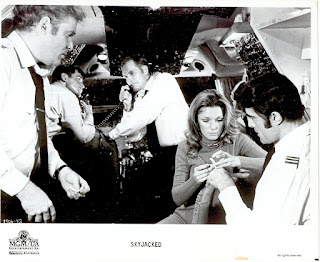Note: this review was originally written for Ken Begg to appear on www.jabootu.net and has been published here by his kind permission.
HANDS OF STEEL (1986 - color)
HANDS OF STEEL (1986 - color)
"A killer cyborg breaks his programming... and turns out to be a swell guy!"
I didn't expect this. An Italian film shot in the United States, ripping off both The Terminator and Billy Jack (!!??), and it actually isn't bad as Italian ripoffs go! That may seem faint praise, but it's really quite an achievement!
Still, you have to wonder who John Saxon crossed to get him sentenced to appear in junk like this and Invasion of the FleshHunters. The occasional A Nightmare on Elm Street must have felt like Christmas-time during this period of his career.
It's the not too distant future (1997, according to the box) and the country, and supposedly the world, is in trouble.
City streets are filled with dirty bums, and there's been massive ecological disaster (some sections of the country experience downpours of acid rain, which can eat through the roof of a car but isn't as tough on paint/windshield wipers/rubber tires/etc as one might expect).
One man, a blind Reverend, seems to hold the key to the future. What makes him so important is rather ambiguous, but he seems to have some ideas for new environmental policies that have made him a hero to some and a menace to others. For instance, the head of a standard issue EEEE-vil corporation doesn't like him. (We can tell what he is despite never really being told, because he meets his henchmen in a nice office in a large building and he always wears a suit, and he has access to helicopters, assassins, and science-fiction-based weaponry. And he's played by John Saxon.)
Saxon has sent his specially-trained cyborg, Paco, to kill the holy man. At the last minute, Paco regains his senses and only wounds the guy before taking it on the lamb. At a truck-stop in the desert, Paco meets up with pretty bar owner Linda, who gives him a job and sets him up with a room. Paco quickly regains his humanity, but is still finding uses for his bionic implants. He must make use of them, for instance, when some rowdy truckers stop by.....
I thought I was in for a tough ride when the opening proved so wildly overacted and cheap, and I thought the numerous American flags all over the place was meant to convince us this isn't being shot in Italy (later we'll see much footage of what is unmistakably the Arizona desert).
Countless Italian films of this vintage tried (usually in vain) to convince audiences that said films (usually quite dreary) were actually American in origin. In fact, Italian film directors, actors, and crewmen assumed bogus Anglo-sounding names in furtherance of this charade. The reason was simple enough, American movies always played well in foreign theaters. And, in fairness, the ploy has happened in reverse...
Imagine my surprise when I found myself being drawn into the story! The acting improves greatly after the opening, and the film doesn't look so cheap when we reach the wild west. Our star (Falcon Crest's Daniel Greene) and starlet (Janet Agren) have enough conviction and charisma to sell this stuff, and I was pleasantly surprised by how much I enjoyed the picture. It certainly made up for the lackluster reaction I'd had to Counterforce.
That's not to say the film isn't filled with silly stuff. Obviously it has some incredibly goofy material. First and foremost is the very dynamic of the story. Saxon is hunting down Paco for fear the rogue robot will lead back to him being behind the attempt on the Reverend's life. To do this, he sends his goons out to follow the trail and they kill everybody they meet once they get the information they need. Needless to say, the FBI is soon as interested in them as they are in Paco.
The bad guys also have that annoying habit of shooting each other the exact second they are of no further use. Best of all, although Paco is bulletproof (really), Saxon's men keep trying to shoot him. Saxon himself eventually takes up a gun and tries to shoot Paco, even though he should know it will have no effect. The rocket launcher he also uses makes a bit more sense.
At one point, Paco finds
himself fighting another cyborg when one is sent to kill 'the traitor.'
This sticks out because there doesn't seem to be anyone who could have
sent her (the enemy cyborg is female, thus pre-figuring Terminator 3, Rise of the Machines).
The FBI didn't send her, nor did Saxon, so she just pops up out of
nowhere.
We also learn that cyborgs are very rare, so much so that the FBI is largely unaware of their existence, and Paco is the first real success in the field of bionics. So again, where did the fembot come from? And how did she track down Paco? She seems to be with the redneck truckers who have a grudge against Paco, but they don't know he's a cyborg so how would they know to call in another cyborg? We get a fun little action scene out of all this, but it makes no sense at all!
We also learn that cyborgs are very rare, so much so that the FBI is largely unaware of their existence, and Paco is the first real success in the field of bionics. So again, where did the fembot come from? And how did she track down Paco? She seems to be with the redneck truckers who have a grudge against Paco, but they don't know he's a cyborg so how would they know to call in another cyborg? We get a fun little action scene out of all this, but it makes no sense at all!
Another choice moment involves the revenge of a guy who nagged Paco into an arm-wrestling match and then lost. He calls in the Tri-State champion arm-wrestler to put Paco in his place (I would say the arm-wrestling sub plot was to cash in on Over The Top, but that film was still a year away). This match involves a Rube Goldberg system where the loser has his hand snared by a clamp and this opens the trap door to a cage containing a rattlesnake. Needless to say, Paco pushes back his opponent to the position where he gets trapped and the snake emerges.
Paco then karate chops the offending reptile's head off before it can bite into his victim. Not only does the snake change a good three times (maybe four, including the rubber prop that gets chopped), but the whole gag falls apart in the execution. Paco chops the snake right in the palm of the guy's hand, bringing his chop down with enough force to sever the snake's head clean off as if the job had been done with a knife (!) and yet he doesn't break the guy's hand while doing this.
Smart, the picture ain't. But it is a lot better than I was expecting, considering all the potential for a Hindenburg-sized disaster. Goofy, but not bad. In the end, I was glad I got a chance to see the film.
There are some rather naked steals from other movies, though. Paco at one point is seen fixing his mechanical arm, and it couldn't be any more frank about copying a similar scene in The Terminator. The climax, meanwhile, is lifted whole from Billy Jack! Odd little flick.
By the way, the alternate titles (according to the database) for this film include Vendetta of Fury (if I'm correctly translating the Italian title), Arms of Steel, Fists of Steel, Paco - Machine of Death (if my translation of the German title is correct), Atomic Cyborg, and Return of the Terminator!



























































